My Uncle Hugh Cleage playing tennis in the alley behind their house on Scotten. Seems to be quite dressed up for alley tennis. I don’t know who he is playing with.
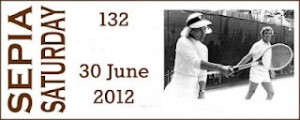


Belle Isle is an island park in the Detroit River. There used to be a ferry that ran from Detroit to Belle Isle but it hasn’t run for years, decades. You can drive, bike or walk across on the Belle Isle Bridge.. From one side of the island you can see Canada, and from the other, Detroit. There are, or use to be, a Conservatory, a petting zoo, a herd of Fallow Deer (I believe disease got them), an aquarium, an exclusive yacht club (Did it ever integrate?), a casino, riding horses, horse drawn buggies, ponies, ice skating, a wonderful fountain that had colored water in the summer (It was done with lights), fishing, picnicking and swimming. We spent a lot of time on Belle Isle when I was growing up. My mother told us that when she was growing up, people slept there during heat waves. In the last few years Belle Isle has been made into a State Park and there is a charge for visiting.
My mother, sister and I seem to have spent the day at Belle Isle with some family friends. Harold and his family are the only family I remember my parents taking us over to their house to visit, as a family.Harold was about Pearl’s age and there was a sister, Andre, and a brother, Edward, who were older than we were. Andre’s mother made her get rid of her Betsy McCall paper dolls at some point because she was “too old to play paper dolls.” Many years later there was a younger daughter, Michelle.
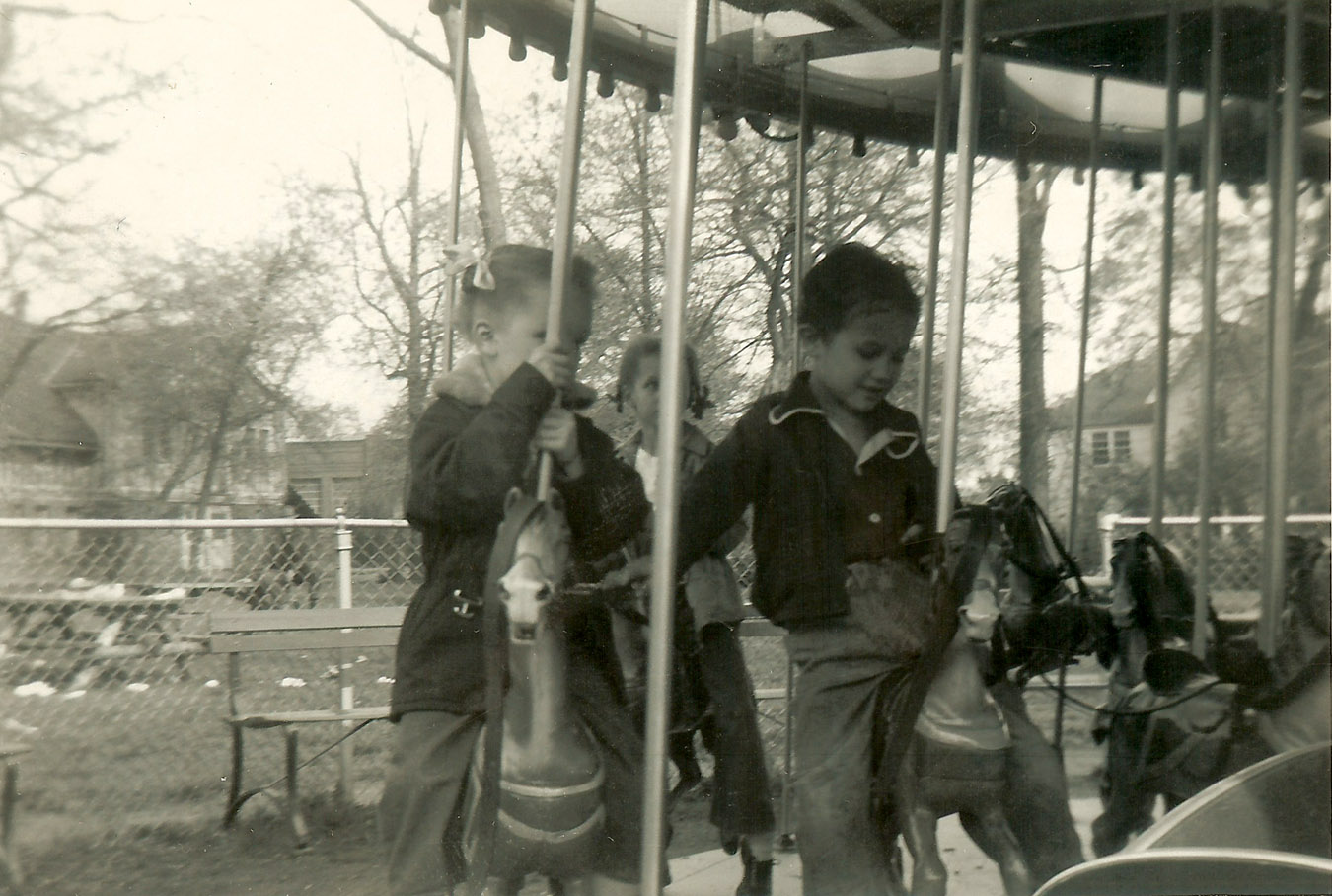
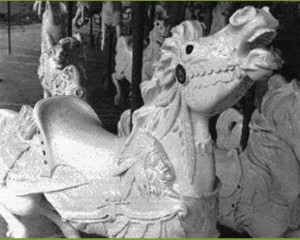
according to the Belle Isle Conservancy page.
It says “Belle Isle” on the back of the photos. I don’t remember so many houses or buildings as you can see in the background. Corrections or confirmation from other Detroiters welcome.
The picture of the horse to the left looks much fancier than the ones we are riding above.

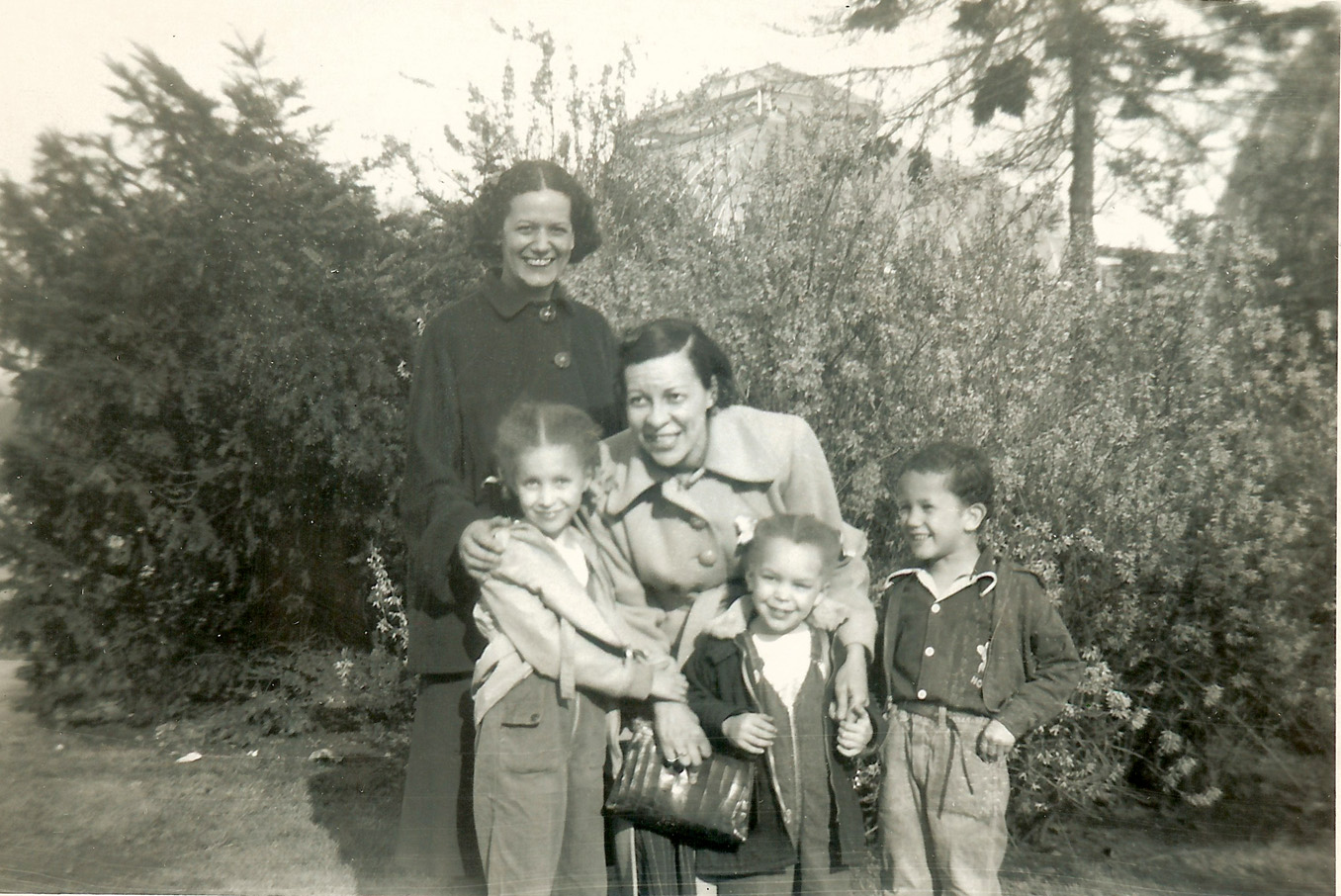
Connie was my mother’s best friend from Eastern High School. She and her husband, Warren, lived on the East side in one of the new little houses built after WW2. We lived on the West side and we only went to visit once or twice a year. It wasn’t in another city though and I don’t quite know why the visits were so infrequent. Perhaps my mother was too busy to go during the school year and Connie didn’t drive because I never remember her visiting us.
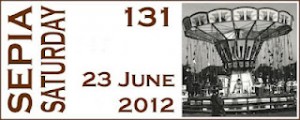
Other posts with photographs taken on Belle Isle Skating Champions and Mershell Cunningham Graham, Jr From a different blog, a post about outtings at Belle Isle back in the 50s and 60s. With photos of various places around the island – Detroit Chinatown: Blast from the past Belle Isle.
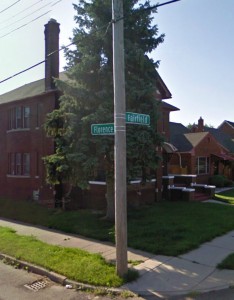 This post continues a series using the Alphabet to go through streets that were significant in my life as part of the Family History Through the Alphabet Challenge.
This post continues a series using the Alphabet to go through streets that were significant in my life as part of the Family History Through the Alphabet Challenge.
In the fall of 1968, Henry, my mother and her parents, Mershell and Fannie Graham, bought the flat at 16201 Fairfield. The Graham home on Theodore had been invaded, shot into and suffered an attempted armed robbery. Nobody had been hurt.
In the spring of that same year an insurance salesman was shot to death in front of our house on Oregon. The murderer cut through our backyard during his escape. Although nobody was home, my mother never felt the same about living there. They began to look for a flat to share.
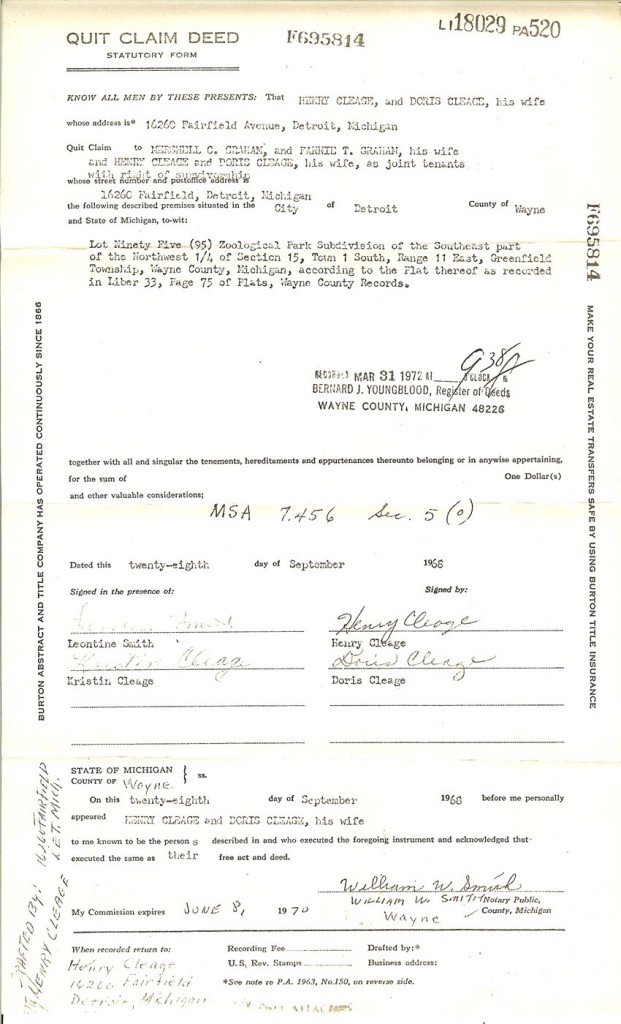
I lived there from the fall of 1968 until I left home in the spring of 1969. My grandparents lived there until they died in 1973 and 1974. My mother and Henry were there until 1976, when they moved to Idlewild. My sister, Pearl, was a sophomore at Howard University when we moved and never lived there, although she came home for holidays.
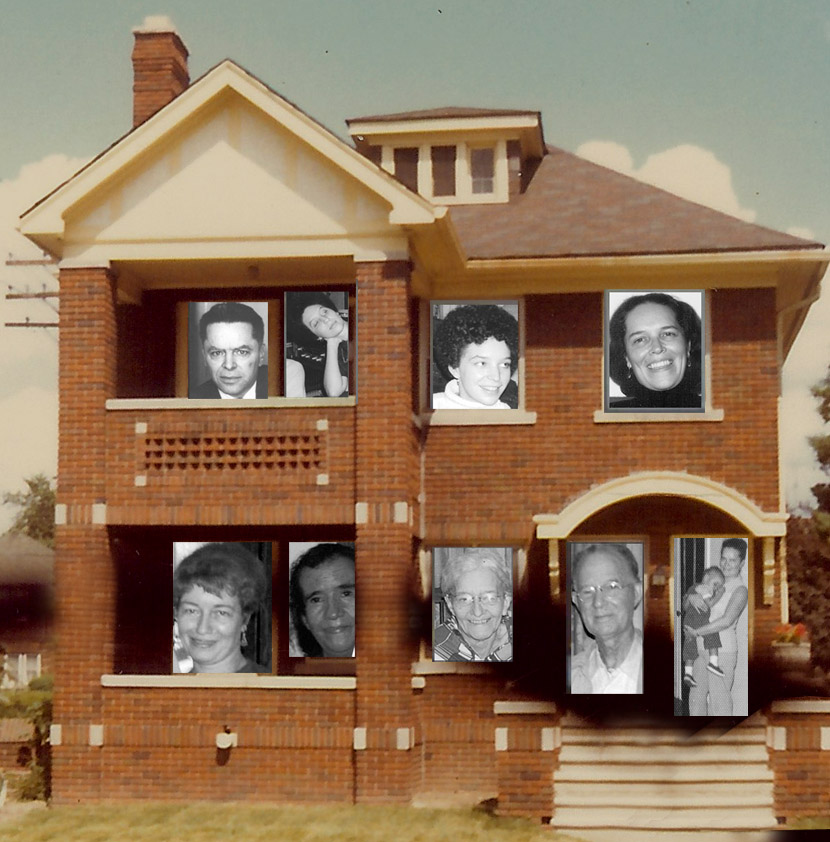
The people in the photos are, starting upstairs and going from left to right – Henry looking firm, me the night before I left on my cross country tour, Pearl and my mother. Downstairs we have my aunt Mary Virginia who lived with her parents for some months, Alice (my grandmother’s youngest sister), my grandmother Fannie, my grandfather Mershell and my mother holding my daughter, Jilo. I got the idea for this photo house from a photograph I saw via twitter of a house in Detroit. You can see it at Detroitsees here.
The flat on Fairfield was kitty-corner from a University of Detroit field. The only thing I remember happening on that field while I lived there was a high school band rally with different bands doing routines throughout a Saturday. I remember staying up late working on art projects and catching the bus across the street to go to campus. Most of my memories are of returning to visit with my oldest daughter. I know that I didn’t spend half as much time as I could/should have spent talking with my grandparents when they were right downstairs.
This house is still standing and looking very good. You can see it on the corner in the street sign photo above. Although the hospital that used to be directly across the street is gone, the rest of the block is all there! Whooooohooooo!
You can see my mother and grandfather’s wonderful garden and read more about Poppy in “Poppy Could Fix Anything.”


Here is a photograph that has quite a bit of damage but still, it is one of my favorite pictures of my father. It was taken on the front porch of my grandparents house at 2270 Atkinson. Today would have been my father’s 101 birthday. He has been gone for 12 years.

When I visited Oakwood Cemetery in Montgomery in 2009 to find some of my family’s burial places, the sexton gave me Records of Interment for those buried in the plots. Along with Dock and Eliza Allen and their 27 year old son Dock, we found the plot for Victor Tulane and his family. In addition to Victor’s Record of Interment I received records for two of his little daughters who died at the ages of 2 years old and 10 months old. There were no names recorded. E ach was identified as “Tulane, Victor (child of)”. Later I found an item of deaths in the Montgomery Advertiser for June 15, 1901 with a list of those who died on June 12, 1901. Again, the baby was listed only as “Child of Victor Tulane.” When the death came up on my genealogy program this morning, I didn’t know which one it was.
In the cemetery plot, there was a stone for Victor and Willie Tulane. Next to it is a flat stone with a large vase on one end. One word is written on three sides of the vase “Tulane”, “Agatha” and “Alean”. Unlike my Uncle Mershell who I memorialized on Sunday, I heard nothing about Agatha and Alean before I went to Oakwood. I only knew about their sister who grew up, Naomi. My cousin, who is Naomi’s daughter, did not remember about them, except to suppose that their deaths were a factor in her grandmother’s fearful and overprotective rearing of her mother.
My mother wrote once that Aunt Willie Tulane had maids and never had to work while her sister, my mother’s grandmother, Jennie was a struggling widow. Although I can’t know this, I believe Aunt Willie would have given up some of her comfort if all of her daughters could have lived to grow up and grow old.
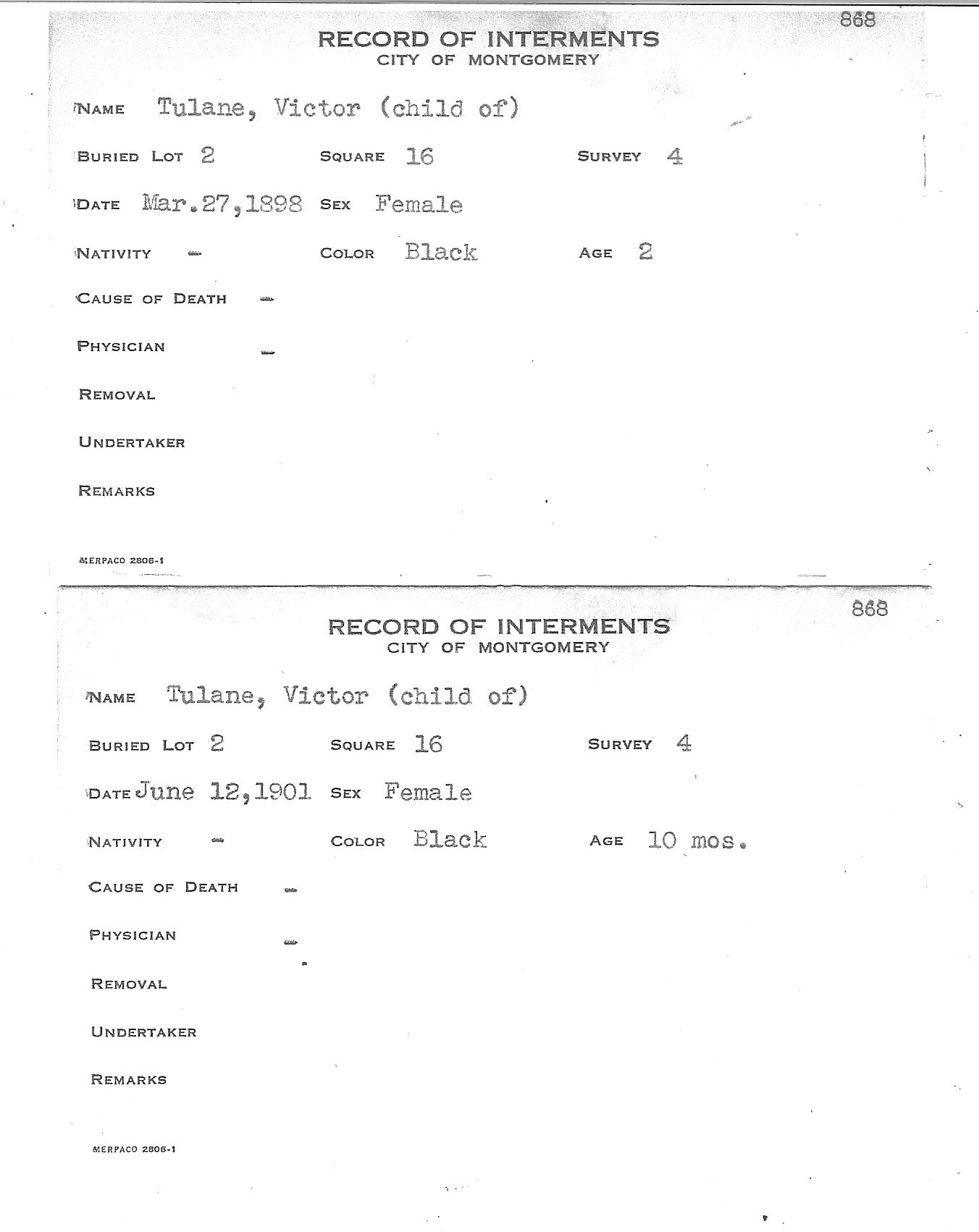

On June 11, 1919 Mershell Graham and Fannie Mae Turner applied for a marriage license in Montgomery, Alabama. They were married by Rev. E.E. Scott at First Congregational Church in Montgomery on June 15. I have no photographs of the marriage or memories that were handed down. I could find no record of their marriage license in the Montgomery Advertiser. They seemed to have no section devoted to “News of the Colored Folk” as some newspapers did.

Soon after the ceremony my grandparents left and returned to Detroit where Mershell was working. I assume they took the train, which would have been segregated at that time. They roomed with friends from home, Moses and Jean Walker. There were other roomers, all of them saving up to be able to purchase their own homes.
To read Mershell’s letter of proposal read The proposal To read Fannie’s letter of acceptance read – The acceptance
I found several marriage related, handwritten poems in my grandparents papers and have printed them below. I wonder if they read these during the ceremony or exchanged them.
The gift
Yes, take her and be faithful, still, and may your bridal bower,
Be sacred kept in after years, and warmly breathed as now,
Remember tis no common tie that binds your youthful hearts
Tis one that only truth should breath and only death should part.
Remember tis for you she leaves her home and mother dear,
To have this world with you alone, your good and ill to share,
Then take her and may future years mark only joys increase
And may your days glide sweetly on in happiness and peace.
Soon, soon I’ll go – from those I love
You, Mother, Sister, among the nest,
Where I will often think of you,
Far in the distant west.
Farewell, Mother, though I leave you
Still I love you, Oh! believe me
and when I am far away
Back to you my thoughts will stray.
Oft, I’ll think of you and home
Though in other lands I’ll roam.
Yes, though miles may intervene,
I will keep thy memory green
Mother, sister, from my heart
Thoughts of thee shall never depart.
Mershell Cunningham Graham Jr was born at 7:45 pm on June 10 in 1921, a Friday, He was the first son and second child of Mershell and Fannie (Turner) Graham. He was delivered at Dunbar Hospital by Dr. Turner. Mershell was a big baby, weighing 8 1/2 pounds. He joined older sister, 14 month old Mary Virginia. Twenty months later his younger sister, my mother Doris, joined them.
Mershell was an active boy, falling down the clothes chute and breaking a window during a game of “who can hit their head against the window the hardest” with his younger sister, Doris. In family photographs, he shows no fear of the ferocious puppy or the family chickens.
On November 1, 1927, he was hit by a truck on his way back to school after lunch. He died just after midnight on November 2. My sister, cousins and I grew up with warnings to be careful crossing the street and to remember what happened to Mershell.
My mother wrote on the page of practice writing above “Mother teaching him to write his name.”
Related links – Births, Deaths, Doctors and Detroit Part 1; 1940 Census – the Grahams – Supplemental Material; Go Bury thy sorrow – complete words and tune.